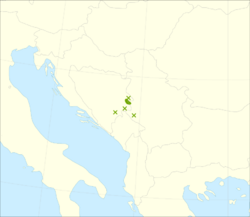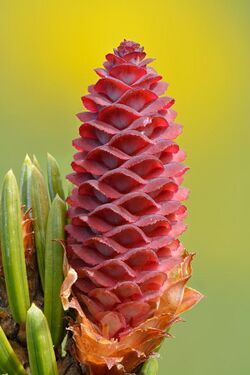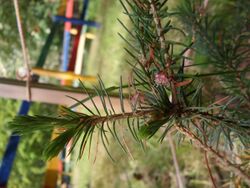Biology:Picea omorika
| Picea omorika | |
|---|---|

| |
| Pančić spruce foliage, showing the blue-green undersides of the needles | |
| Scientific classification | |
| Kingdom: | Plantae |
| Clade: | Tracheophytes |
| Clade: | Gymnospermae |
| Division: | Pinophyta |
| Class: | Pinopsida |
| Order: | Pinales |
| Family: | Pinaceae |
| Genus: | Picea |
| Species: | P. omorika
|
| Binomial name | |
| Picea omorika (Pančić) Purk.
| |

| |
| Natural range | |
Picea omorika, common name Pančić spruce[2][3] or Serbian spruce (Serbian: Панчићева оморика, Pančićeva omorika, pronounced [pâːnt͡ʃit͡ɕɛv̞a ɔmɔ̌rika]), is a species of coniferous tree endemic to the Drina River valley in western Serbia, and eastern Bosnia and Herzegovina, with a total range of only about 60 ha, at 800–1,600 m (2,625–5,249 ft) altitude. It was originally discovered near the Serbian village of Zaovine, on Mount Tara, in 1875, and named by the Serbian botanist Josif Pančić;[4][5][6] the specific epithet omorika is simply the Serbian word for the tree. (All other spruces are smrča.)
Description
It is a medium-sized evergreen tree growing to 20 m (66 ft) tall, exceptionally 40 m (131 ft), with a trunk diameter of up to 1 m (3 ft). The shoots are buff-brown, and densely pubescent (hairy). The leaves are needle-like, 10–20 mm long, flattened in cross-section, dark blue-green above, and blue-white below. The cones are 4–7 cm (2–3 in) long, fusiform (spindle-shaped, broadest in the middle), dark purple (almost black) when young, maturing dark brown 5–7 months after pollination, with stiff scales.[4][5][6]
Cultivation
Outside its native range, Serbian spruce is of major importance as an ornamental tree in large gardens, valued in northern Europe and North America for its very attractive crown form and ability to grow on a wide range of soils, including alkaline, clay, acid and sandy soil, although it prefers moist, drained loam.
It is also grown to a small extent in forestry for Christmas trees, timber and paper production, particularly in northern Europe, though its slow growth makes it less important than Sitka spruce or Norway spruce. In cultivation, it has produced hybrids with the closely related black spruce P. × Machala and also with Sitka spruce.[4][5]
AGM cultivars
The following cultivars have gained the Royal Horticultural Society's Award of Garden Merit:[7]
Ecology
Because of its limited range, it is not a major source of nutrition to wildlife, but does provide cover for birds and small mammals. Prior to the Pleistocene ice ages, it had a much larger range throughout most of Europe.[4]
References
- ↑ Aleksić, J.M.; Ballian, D.; Isajev, D.; Mataruga, M.; Christian, T.; Gardner, M. (2017). "Picea omorika". IUCN Red List of Threatened Species 2017: e.T30313A84039544. doi:10.2305/IUCN.UK.2017-2.RLTS.T30313A84039544.en. https://www.iucnredlist.org/species/30313/84039544. Retrieved 12 November 2021.
- ↑ Cabi, Wallingford; Cabi Invasive Species Compendium, Oxon (Oxford), UK (2019). "Picea omorika (Pancic spruce)". https://www.cabi.org/isc/datasheet/41136.
- ↑ Gligić, Vojin; Šilić, Čedomil (2021). "Pančićeva omorika". https://www.plantea.com.hr/panciceva-omorika/.
- ↑ 4.0 4.1 4.2 4.3 Farjon, A. (1990). Pinaceae. Drawings and Descriptions of the Genera. Koeltz Scientific Books ISBN:3-87429-298-3.
- ↑ 5.0 5.1 5.2 Rushforth, K. (1987). Conifers. Helm ISBN:0-7470-2801-X.
- ↑ 6.0 6.1 Rushforth, K. (1999). Trees of Britain and Europe. Collins ISBN:0-00-220013-9.
- ↑ "AGM Plants - Ornamental". Royal Horticultural Society. July 2017. p. 78. https://www.rhs.org.uk/plants/pdfs/agm-lists/agm-ornamentals.pdf.
- ↑ "Picea omorika". https://www.rhs.org.uk/Plants/12966/Picea-omorika/Details.
- ↑ "RHS Plant Selector Picea omorika 'Nana' AGM / RHS Gardening". Apps.rhs.org.uk. https://www.rhs.org.uk/Plants/99400/Picea-omorika-Nana/Details.
- ↑ "RHS Plant Selector Picea omorika 'Pendula' AGM / RHS Gardening". Apps.rhs.org.uk. https://www.rhs.org.uk/Plants/90723/Picea-omorika-Pendula/Details.
External links
- Picea omorika - information, genetic conservation units and related resources. European Forest Genetic Resources Programme (EUFORGEN)
Wikidata ☰ Q147824 entry
 |






